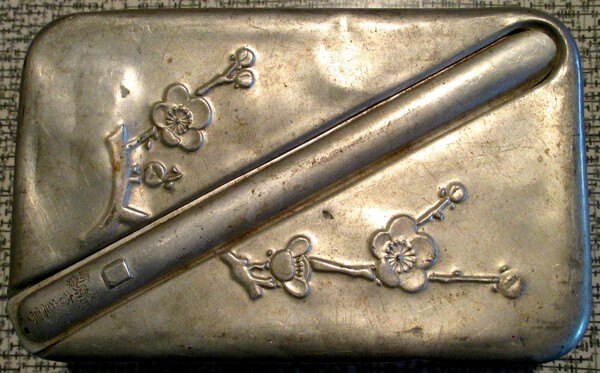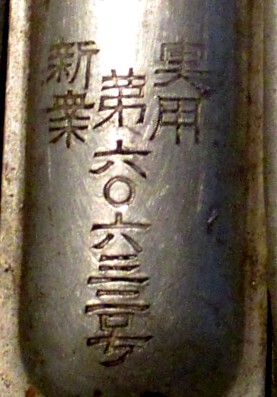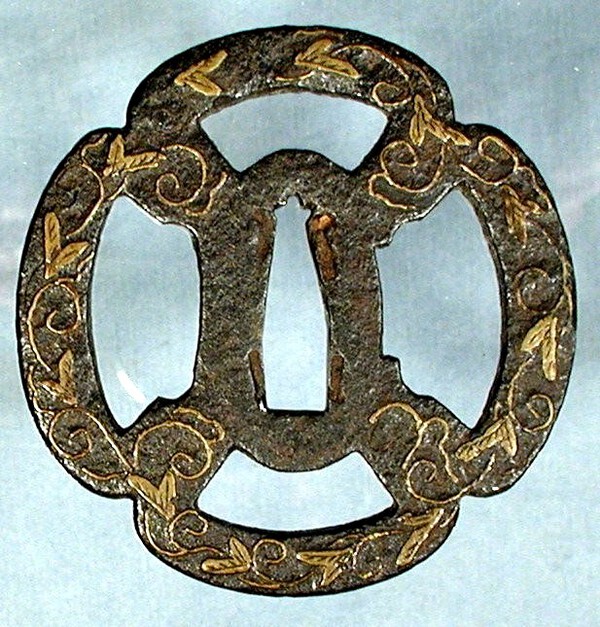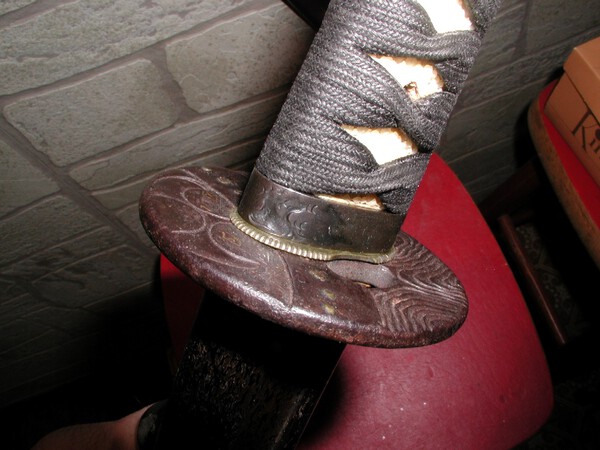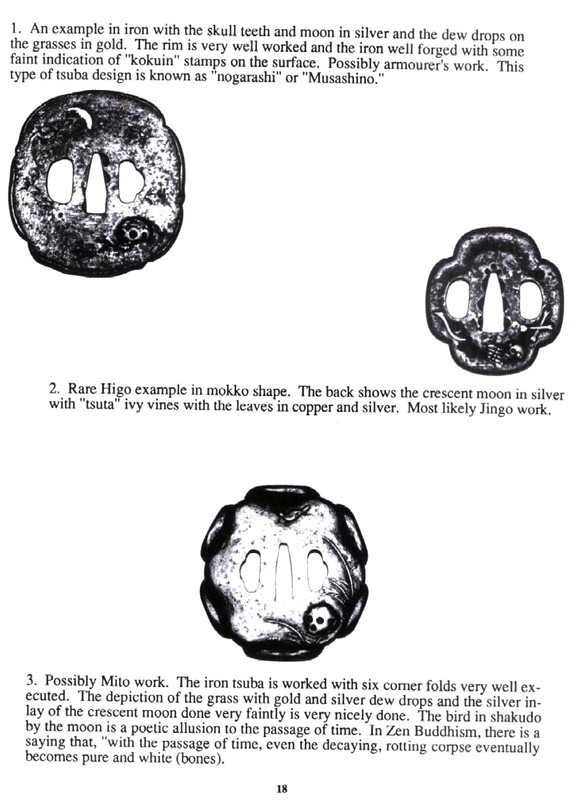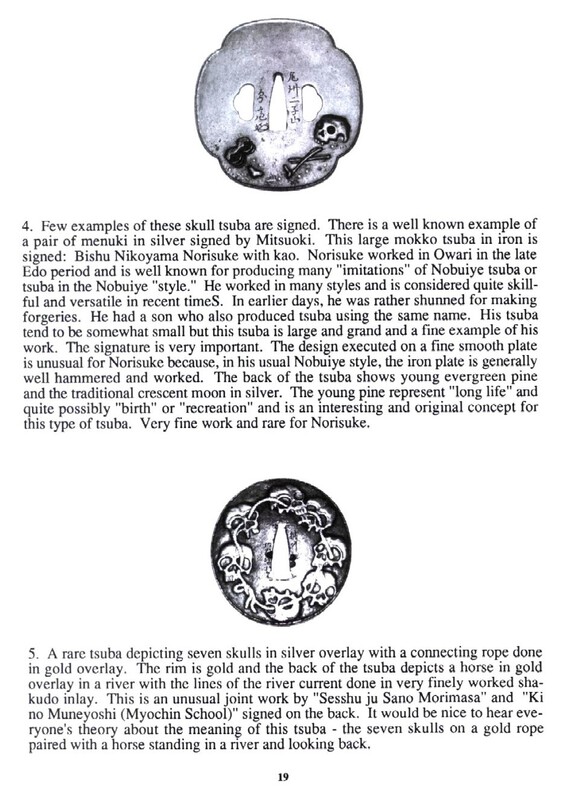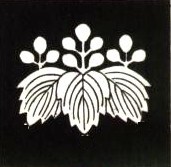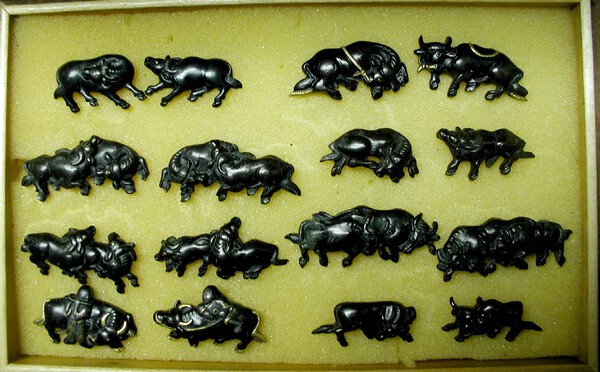-
Posts
703 -
Joined
-
Last visited
-
Days Won
4
Content Type
Profiles
Forums
Events
Store
Downloads
Gallery
Everything posted by Ron STL
-
Grev, I believe that little book was one of my very first books on tsuba, purchased around 1970. The little book plus Robinson's book peaked my interest in fittings, an interest that has only increased over the decades. Good luck on your project. Ron STL
-
Thanks Morita san. Wonder if the aluminum came from old airplanes, being post-war. It wouldn't surprise me. I'll pass this info on to my friend. Appreciate the information. Ron STL
-
That was a local opinion, too. I was hoping somebody would translate the full instription for me. Curiosity? Ron STL
-
Buy some worthy books and handle as many "quality" swords as possible and absorb what you see. Once you learn what a quality made sword (the steel, the shape, etc.) should offer, look for that first before looking at the nakago. To this day, I never remove a tsuka until I've formed an opinion after looking over the "blade" itself. If unimpressed, likely the sword will prove to be not particularly noteworthy of your time. As for the mei on the sword discussed here, at first glance I thought to myself, hmmm...that mei looks a bit funky. This is what Chris pointed out. You need to familiarize yourself with what these things "should" look like. Of course this is what hooks one into become a life long collector, always looking for the next "good sword" to purchase! But it's fun! Ron STL
-
Apologies if this is a misplaced topic, but perhaps not. Inquiring if anyone knows what this item is and if it might be Japanese military issue. It is a pressed aluminum box with a compartment on the lid that slides open and holds metal chop sticks. First, it would seem unusual to use aluminum for a military "kit" during the war. There are markings cut into the box which are numbers (260632)...shin something...anyone explain this? Have a "serial number" (?) could indiate military. Just an interesting item to learn something about. Ron STL
-
The tsuba certainly doesn't look poor quality to me. It very much resembles a large Nobuiye that is owned locally. It is boxed and has the owner's hakogaki calling it Myochin Nobuiye. The surface of this local tsuba is definitely more...has more "luster" to it, let's say...but I wonder if your tsuba, Random, might fall into this late Myochin school of craftsmen. I suspect it is rather thin and large? It would look fine on your sword or kept in a box for appreciation. Ron STL
-
Thanks Matt, you're 100%! I thought the first kanji looked like Mori but the bottom "box" threw me. It's not box shaped (5 strokes) but just not as well defined as it in Mori (six strokes). The Kata character threw me and I'm surprised I didn't see it in the books, being not a complicated character. Appreciate the help. Will pass this on to my friend. Ron STL
-
That's a large and very nice looking Yoshiro mon sukashi tsuba. Be happy. Ron STL
-
Searching for the correct reading of this smith's name and also, if anyone knows anything about him. I've searched through Bungo-to without success. The sword belongs to an out-of-state friend who is equally stumped. Thanks. Ron STL
-
Mikolaj, you have some very nice tsuba there. Enjoyed seeing them. Attached are two examples that are here. The first one is brass inlay on a very uneven Tempo plate (which resembles one of Mikolaj's tsuba). This one measures 85mm x 82.5mm x 4mm. John Yumoto said when I showed this to him that inlay artists would buy Tempo plate tsuba and inlay the rough, uneven surface to "show how good they were at inlaying." The second tsuba (mokko shaped) is one my earliest found tsuba measuring 74mm x 73mm x 4mm. . I showed this tsuba to Morihiro Ogawa back in the early 1970s and he identified it as Heianjo. This was my earliest exposure to Heianjo brass inlay tsuba, a stepping stone in my collecting years. Both tsuba remain here today, still appreciated. Ron STL
-
I looked again at the f/k and the fuchi does have that same wonderful technique used to show the clouds on the kashira. It is just out of sight (on the other side) in the fuchi photo. Seeing this, I'm sure the f/k are made together. The "soft" look technique on those clouds is just wonderful, to my eye. I took a quick photo (very quick) of this side of the fuchi to show this. Ron STL
-
Okay, I've tried more photography which might still be not up to par, but the best that my camera (and the photographer) can do. The color is somewhat off on the kozuka, being shibuichi, but you get the picture. I've also check the Fitting Museum certificate and as expected, it does attribute the work to Osuki school. A lovely theme, I am also attaching an iron tsuba that's here, signed Masayoshi (kao) that received TokuHo level paper. The theme is the same and may very well also be Osuki work. I've never figured out just who Masayoshi was, but have always loved the tsuba. Also photographed is a fuchi and kashira, shakudo, mumei, that is on the tsuka of a wakizashi of mine that is mounted in handdashi-style koshirae. Being shakudo, perhaps the f/k could fall into Osuki kinko work. Open for discussion of course, all "learning" for me. I've also copied the TokuHo paper and Museum certificate so you can read what it says about the tsuba and kozuka. As for the "bird," I suspect it is indeed a nighengale. Hope you enjoy the fittings and that somebody can expand upon their origins. Ron STL
-
Perhaps it is Otsuki. If so, I mispelled it in my records. Running out the door, but will check the actual certificate tomorrow and post a copy of it then. Sorry for the rush-rush. Ron STL
-
Pictured here is a very nice shibuichi kozuka of flying bird, moon and clouds. The bird is relief in shakudo, the moon in relief, silver with some clouds. Clouds and rain of gold hira-zogan. There is a signature (more likely a catalogue marking?) on the end of the kozuka. The kozuka came with a certificate from the now closed fittings museum designating this work of the Osuke school. Can someone enlighten me on the Osuke group and their work? Also, does anyone have any idea what this "mei/marking" is all about? I do know that years ago a German collection was auctioned off and that the house "stamped numbers" on seppa-dai of tsuba (once owned one). Thanks in advance. Ron STL
-
The work appears very nice with (from the back) nice walls and finishing. I wonder if today these would be called Kyo-kinko, later Edo. Ron STL
-
Lots of very interesting examples coming in. Thanks! After back home again from the San Francisco show, I'll select some of these examples to include in my JSS/US article. Will clear this with the owners, NMB, etc., at that time. What this has shown me is what little I knew of the subject and its meanings. Hope I can pull this all together into a meaningful article. Meanwhile, continue to post examples if they are available. I will be kicking around the show all weekend. Ron STL
-
Thanks Tom. The koshirae was papered to late Edo, so that would fit your thinking that the kogai was late. Ron STL
-
This request is related to the tanto with the double mon kogai I asked about. I decided it would be interesting to expand the JSS/US article on the skull theme tanto koshirae and include an old article on the subject. This was an article by the late Kensho Furuya titled, "Gaikotsu - The Skull Motif in Japanese Sword Fittings," JSS/US Newsletter, July-August 1995. The last two pages of that article pictures five tsuba. Rather than reproducing these preprinted photos, being I think known tsuba, can anyone come up with more clear photos of these tsuba or at least direct me to a book they might be in? It might also be interesting to share your own photos of this motif that you would allow me to include in this article. An interesting motif, this could provide some interesting reading as a topic here on the NMB. Ron STL
-
Hey, don't count me out just yet! John, what you wrote is what the design book reads. I'm trying to put together a short article for the JSS/US on a skull motif tanto and this kogai is part of that koshirae. Looks like it would be best to leave the double-mon comments to something general as you put it here. Just trying to avoid saying anything misleading. Ron STL
-
Does anyone care to comment on the use of two mon when displayed on fittings or a koshirae? I realize it is very difficult if not impossible to pin down a mon to a specific family (since there was a time when literally everyone had a mon). It was explained to me that families often had a primary and secondary mon. I was reading in "The Elements of Japanese Design" (p.14) that is was necessary for families to designate a mon as its official mon (jomon) with a supplementary mon (fukumon) being secondary. I'm not sure what can be said about this, but let's see if anyone can expand upon this topic. The kogai (attached) displays two forms of the kirimon. These look to be like the two book examples, also attached. Ron STL
-
Oxen seem a popular theme More oxen menuki, late muromachi/early edo, shakudo ko-kinko, nbthk hozen Sorry, but I couldn't resist showing what I affectionately call "Ron's cattle farm," my collection of oxen menuki. A number of these would be Momoyama era (specifically the ones with gold spots) and other would fall into early Edo, middle Edo. The gold pair are late Edo by Kikuchi Tsunatomo (mei plates on reverse), the only signed pair of the bunch. For years I purchased most oxen menuki that came my way, if of good quality, in order to compare workmanship and techniques used to make and decorate them. One thing that fascinated me was to pay attention to the "hair" between the horns of the oxen and how that was represented. By the way, it was the late Tom Buttweiler who got me interested in early menuki and tsuba back in the mid-1970s. Ron STL
-
I've found that typically, the nakago-mune on shin-to katana are noticably maru-mune. On ko-to katana they are more flat or almost flat. As for shinshin-to, I'd like to say the nakago-mune would more look ko-to but the rest of the blade's sugata and nakago should make its newness fairly obvious. Always tough to judge the overall "blade" in this condition. Ron STL
-
At first, seeing the overall sugata made me think "very old tachi," but seeing more, that's not the case. The size and apparent weight (denseness) of the sword and seeing the beautiful choji mixed hamon brings me to either sue-koto or shinshinto work. The boshi carries on the hamon, a koto style and shinshinto style. The clear and strongly carved long mei and a date (so it appears) looks more shinshinto to me. The jihada does look more koto to me, but you do see this in shinshinto, too. Adding all this up in my aging mind, I suspect this is shinshinto and by a follower of Masahide. It'll be interesting to see more opinions and then what the mei and date is. All in all it looks like a very beautiful and impressive sword! Ron STL
-

Chicago Sword Show
Ron STL replied to Mark's topic in Sword Shows, Events, Community News and Legislation Issues
Sitting here today to see what will go to Chicago for my table. One item might interest those interested in Minatogawa swords. I believe to have the (captain's rank) hat and epaulets in leather travel box that belonged to Matsushita Hajime. He was in charge of Etta Jima, the naval academy. A steamship label has the name but the "Hajime" part is badly worn. Pretty package. On-going mystery here...how to confirm the name 100%. Not exactly a sword item, but it'll be on my table. No room to display it properly here. Mark, best wishes for a good show!!! At least four from St. Louis will be there! Bar will be busy, I'm sure! Ron STL


